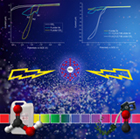Publication
821
Chem. Eur. J., 23 (20), 4782-4793, 2017
DOI:10.1002/chem.201605546
|
|
|
|
|
|
 |
Local Proton Source in Electrocatalytic CO2 Reduction with [Mn(bpy-R)(CO)3Br] Complexes
|
|
|
|
Federico Franco, Claudio Cometto, Luca Nencini, Claudia Barolo, Fabrizio Sordello, Claudio Minero, Jan Fiedler, Marc Robert, Roberto Gobetto and Carlo Nervit
Department of Chemistry and NIS University of Turin Turin Italy
Univ. Paris Diderot, Sorbonne Paris Cité, UMR CNRS 7591 Laboratoire Electrochimie Moléculaire Paris 13 France
The electrochemical behavior of fac-[Mn(pdbpy)(CO)3Br] (pdbpy=4-phenyl-6-(phenyl-2,6-diol)-2,2′-bipyridine) (1) in acetonitrile under Ar, and its catalytic performances for CO2 reduction with added water, 2,2,2-trifluoroethanol (TFE), and phenol are discussed in detail. Preparative-scale electrolysis experiments, carried out at −1.5 V versus the standard calomel electrode (SCE) in CO2-saturated acetonitrile, reveal that the process selectivity is extremely sensitive to the acid strength, producing CO and formate in different faradaic yields. A detailed spectroelectrochemical (IR and UV/Vis) study under Ar and CO2 atmospheres shows that 1 undergoes fast solvolysis; however, dimer formation in acetonitrile is suppressed, resulting in an atypical reduction mechanism in comparison with other reported MnI catalysts. Spectroscopic evidence of Mn hydride formation supports the existence of different electrocatalytic CO2 reduction pathways. Furthermore, a comparative investigation performed on the new fac-[Mn(ptbpy)(CO)3Br] (ptbpy=4-phenyl-6-(phenyl-3,4,5-triol)-2,2′-bipyridine) catalyst (2), bearing a bipyridyl derivative with OH groups in different positions to those in 1, provides complementary information about the role that the local proton source plays during the electrochemical reduction of CO2. |

